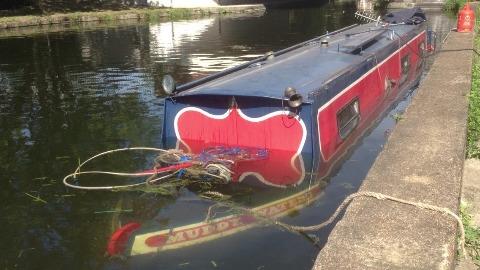Sinking Is Every Narrowboaters Worst Nightmare!
Every boaters worst nightmare is for their boat to sink, especially if it's due to their mistake. Apparently boat sinkings are on the rise, according to the River Canal Rescue they numbered 119 during 2015-2016! Which is a fifty percent rise from the previous year. In this article we talk briefly about how to minimise the risk of sinking your narrowboat.

Main Causes of Sinking
Some of the major causes of sinking are; water in the engine room, leaking stern glands, failing to pump bilges, weedhatch faults and getting caught on lock cills or lockgates.
Avoiding stern gland Leaks
At the end of each day of cruising it is good housekeeping to grease the stern gland, this is best done whilst the engine is still hot. To do this, turn off the engine and locate the stern tube greaser, make sure it is filled with grease, turn the tap until you feel the resistance. This will pack the stern gland with grease and keep it in good order by putting a layer of grease between the shaft and the tube. If this does not stop the leaking it could be that the packing needs replacing , which is best done when the boat is out of the water. See our video on how to grease a stern tube below;
Avoiding Engine Bilge Flooding
Good deck covers are a must to keep water out of the decks. Ensure any drainage points are kept maintained and clear of any debris, this will reduce the amount of water likely to make its way into the engine bilge. Most bilge pumps are wired with automatic on-off switches and are automatic so that you can leave them aboard to kick in should the need arise. However remember that automatic bilge pumps will fail if the electricity supplying them is interrupted. So make sure that you regularly visit the boat to check. A good tip is to carry a spare bilge pump.
Weed Hatch Faults
If your weedhatch cover is not fitted properly or is left off, water can ingress and flood the engine room very quickly causing the boat to sink.
Before every journey check that the hatch cover clamps are secure and tight and the hatch is fitted correctly. Regularly inspect the hatch and seals for corrosion. see our video on how to inspect the weedhatch below;
Danger in Lock Gates and on Lock Cills
When entering a lock make sure that the lock gate opens fully to avoid getting stuck. Keep clear of the cill which is a ledge that protrudes below the water line and is usually marked on the edge of the lock side (see picture below) Be careful as this ledge can can catch the unattentive and make the boat lurch and sink.
If you're travelling downhill in the lock chamber and your stern or rudder gets caught on the cill when the water recedes, the bow of the boat will lower as the water recedes leaving the stern raised and capsizing can occur in seconds.
If you do get the stern stuck going uphill, close the bottom lock gate paddles to stop water emptying further and slowly open the top gate paddles to refill the lock, keeping the boat in the middle of the lock chamber.
If you get the bow stuck under projection of the top gate when travelling uphill, you will need to close the top lock to prevent the lock filling and open the bottom paddles to allow the water level to fall. 
Other Risks of Sinking
Too tight ropes, flooded foredecks and stuck fenders are all other risks involved with causing a narrow boat to sink.
Ropes
Make sure that any centre lines you use to control the boat in a lock is only ever half looped around a bollard. Never tie a rope to any bollard whilst in a lock. If mooring on tidal water or a river, leave enough slack to allow for the water level to change.
Flooded Foredecks
Avoid opening the lock gate paddles too early when ascending. Open the ground paddles first until the lock is half full, then open the gate paddles to avoid a fountain of water hitting the boat and flooding the foredeck.
Stuck Fenders
Fenders can easily get stuck when going through a lock, so be aware and keep your eye on the boat, don't get distracted. Good advice is not to use side fenders when navigating narrow locks.
Hull Maintenance
Keep your boats hull well maintained and regularly blacked to ensure that no holes appear. Any outlet holes on the side of the boat such as for sinks and showers should be well above the water line by at least 15cms. If they are too close to the water line water could ingress and gradually sink the boat if not pumped out.
What to do if your narrowboat Sinks
Above all ensure that you and all your crew members are all safe.
Contact your insurer who will ask for a specailist recovery firm to salvage the boat. Contact a salvage expert and the Canal and River Trust or waterway authority where the boat sank. Most insurers will ask for at least one quote for repair works so it is always advisable to speak to your insurance company first and get their approval before you go ahead with recovery and repairs.
Do Take Care Aboard Your Narrowboat and let us know your tips for keeping afloat, by commenting below!